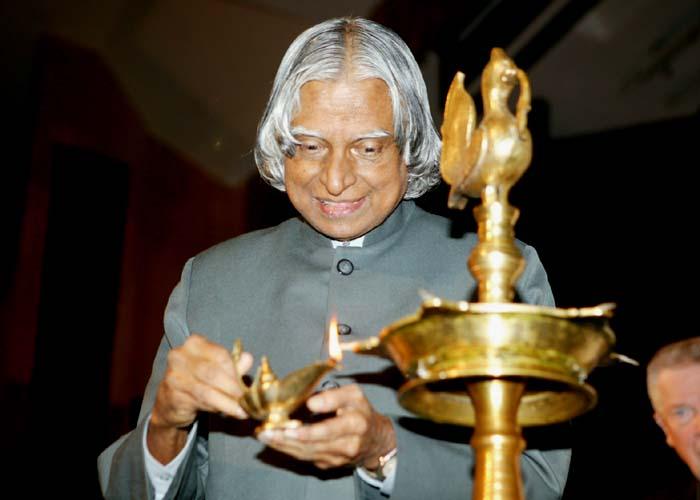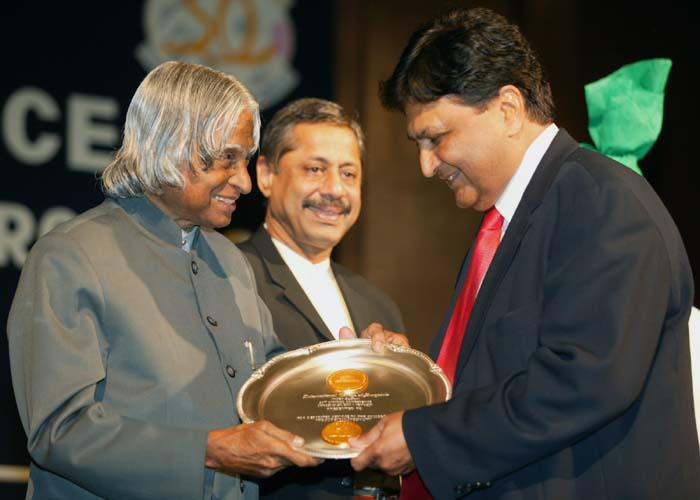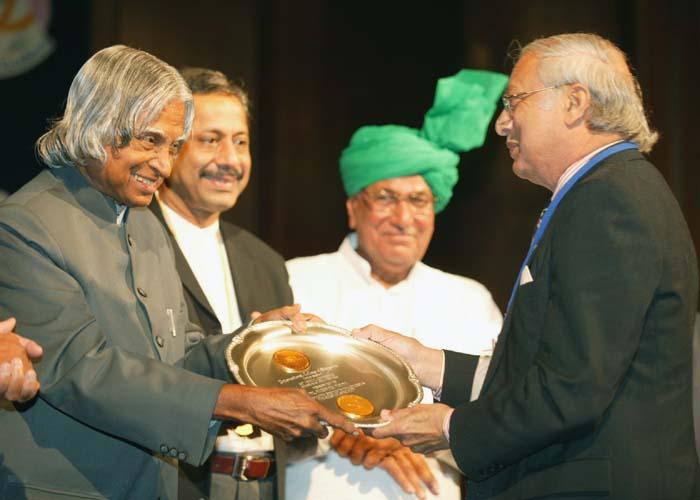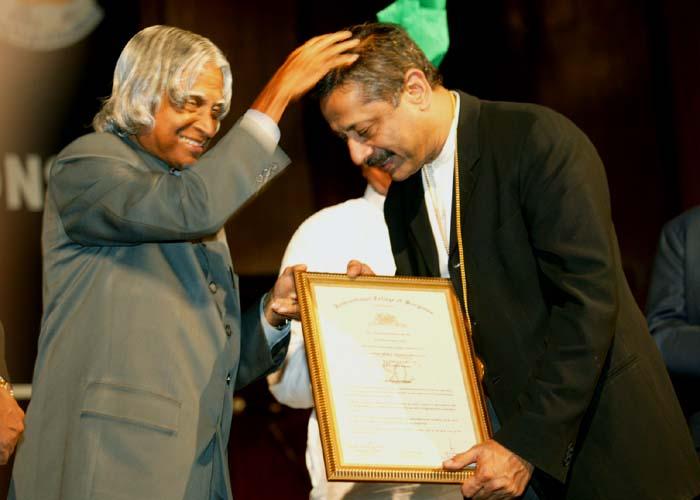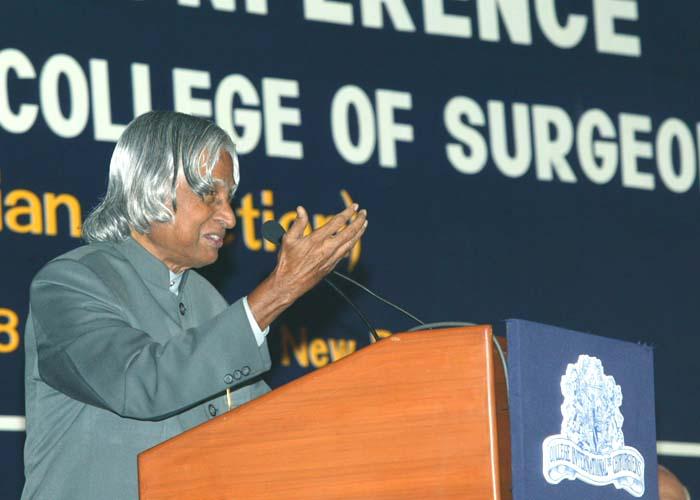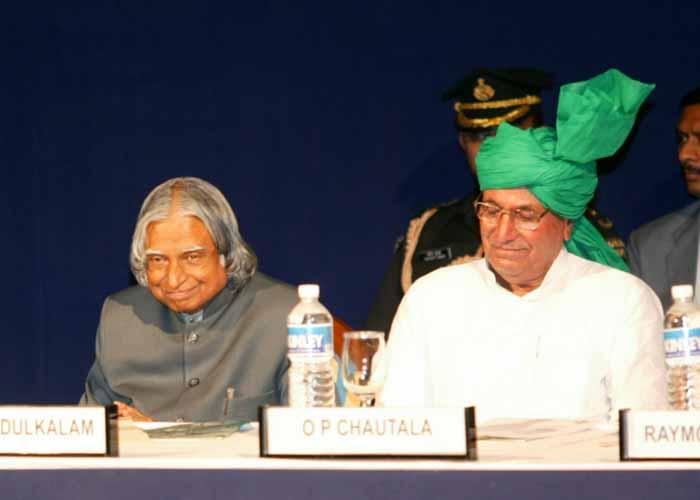Address At The Golden Jubilee Conference Of The International College Of Surgeons (Indian Section)
New Delhi : 29-10-2004
The Touch that Enlightens the World
I am delighted to participate in the Golden Jubilee Conference of the International College of Surgeons (Indian Section). I greet the organizers, members of the International College of Surgeons, medical practitioners, pharmacologists, paramedical staff, academicians and distinguished guests. Dear friends when I am in the midst of International College of Surgeons, for me, you are the surgeons of surgeons. At this hour, I am reminded of the famous statement by Norman Cousins in his book, ?Anatomy of the illness? ?Patients are today reaching out to the doctor not just for medical help. They are reaching out for kindness, assurance and hope.? I would also like to share with you a quote in the paper which I came across on the topic ?One World, one people, one surgery? by Dr.T.E.Udwadia which states: ? The poorest of the poor have as much right as anyone to less pain after surgery, reduced medication, less morbidity, shorter hospitalization, and early return to home, family, and work. Minimal access surgery and the expensive technology it requires is advocated, not as homage or tribute to new technology, but in appreciation of the manifold benefits this new technology gives our patients and our people.? This thought has to be the focus of the Indian Chapter of the International College of Surgeons.
I am happy to note that the International College of Surgeons brings together surgeons and surgical specialists of all nations, races and creeds to promote surgical excellence for the benefit of mankind. I am also glad to know that your organization follows the principles stated by Pasteur: ?Science belongs to no Country, because knowledge is the patrimony of humanity, the touch that enlightens the world.? Can this human touch of Indian surgeons reach our rural population?
Rural Health Care
The Centre for Biomedical Sciences & Technology at Chennai has established the first Cardiology and Cardiovascular Centre in the rural setup in the village of Parumala in Kerala which has a population of 8300. I was happy to note that the Centre had already carried out 300 angiograms, 25 angioplasties with stenting and nearly 100 open heart surgeries including children. This is a good rural development model where high quality healthcare has reached the remote villages and I am sure this facility can be extended as a medical healthcare project to other villages in the country by urban medical institutions. This type of data and work done to the society should be utilized for realizing quality healthcare for the rural sector. At this stage let me narrate an example which touched my heart.
CARE for the hearts
In October 2002, I inaugurated the Care Hospitals telemedicine units at the G.B. Pant Hospital, Tripura, and I interacted with patients at different centers through tele-medicine set up where I came across a 13 year old boy from Kailashar, Tripura. His parents are farm laborers and even a tiny piece of land they own was sold to provide medical treatment to this boy before CARE hospital diagnosed the problem of this boy. This boy was suffering from chronic rheumatic heart disease with severe mitral stenosis. His heart ailment was noticed three years ago, when he complained of breathlessness and chest pain. He was also coughing blood and lost weight, according to his elder brother Ismail Ali. Doctors at Agartala found that his condition was serious and needed specialized treatment which was expensive. He discontinued his studies as he couldn?t take the strain of walking down to the school or even play around with the other kids. He was taken to the CARE Hospital at Hyderabad, and was treated by Dr. B. Somaraju and Dr. Raghava Raju who carried out the balloon dilatation. The entire treatment and travel expenses were borne by the hospital. The boy?s condition is being continuously monitored and he is doing fine. He has also started going to school. CARE foundation has recently started a ?Little Hearts Foundation? through voluntary contributions made by philanthropists. They have so far carried out 150 free heart operations on children.
Now I would like to discuss some of the leading research areas.
Research in Gene Chip
Indian population is highly susceptible for coronary heart diseases that too at a relatively young age irrespective of where they live. As you are aware, Gene Chip arrays have tremendous potential to reach goals from identifying genetic variations associated with heart disease for discovering new drug targets.
Recently, I was in Chennai at Dr. Cherian?s Medical Centre. It is known as, International Centre for Biomedical Sciences and Technology (Research & Applications). There I interacted with Dr. Emmanuel, who is working in the area of Gene Chip. He says the Gene Chip can be used for finding the existence of genetic diseases including coronary artery diseases in the baby during a certain stage of pregnancy itself.
As many as 50 different mutated genes are identified as responsible for heart problems in Indian population. If a person is not having any of these harmful mutated genes, then he may not suffer from heart ailments. The Gene Chip is one which on contacting with the blood, immediately identifies the mutated genes in the person. Based on this information, proper guidance can be given to the patients and parents. The chip could also be modified to suggest to the patient?s system to develop those chemicals which in turn will help the patient recover from the present situation.
It is reported that gene differences between humans and most animals are very nominal. More than 90% of our DNA is similar. This property is a boon to researchers since animal models can be subsequently used for curing human diseases based on trial data. It has also been found that Gene Chips can be used for early diagnosis of tumors and their treatment. Integrating molecular biology, cytogenetics and bio-chemistry, bio-chip technology is regarded as one of the important inventions in the research of gene functions. It is far superior to molecular biological technology in terms of speed and accuracy. I would recommend the medical researchers to progress further in this area for finding the application of Gene Chip as a diagnostic tool and as a treatment regime for many diseases.
Stem Cell Research
The recent identification and characterization of progenitors with stem cell properties has opened up new avenues that may be useful for treating functional impairments caused by the death of specific cell population. The stem cell may help restore functioning of certain defective organs, by repopulating or rescuing the damaged cells from further degeneration. There will be a revolution in the medical treatment for heart care, cancer, visually impaired and mentally challenged. It is essential to launch an integrated national stem cell research program.
During my visit to various laboratories, I happened to see the beginning of stem cell research for different purposes including brain research. I would like to share with you two very important stem cell research applications in the field of cardiology and visual impairment. When I met Dr. P. Venugopal told me about his experiences. He said in one of the cardiac diseases, where conventional, medical and surgical treatment were ineffective because of the affliction of the heart muscle, use of autologous bone marrow stem cells implantation into the diseased heart muscles had been applied in order to improve the function of heart muscle. This kind of application of this procedure is the latest and very few cases have been done in the world, the first time in India. This is expected to open new frontiers in the treatment of patients for regeneration of heart muscles, there by giving new hope for the patients suffering from end stage heart disease. The stem cells are being tried in other diseases like diabetes in order to offer cure for the patients suffering from long term and intractable diabetes. This is being applied by injecting the stem cells into the patient's artery supplying the pancreas. The results are still awaited. The New Scientist (dated 25th September) has reported another remarkable recovery of a heart patient at the Johnn Wolfgong Goethe University at Frankfurt. Of course for the first time, I have come across a warning, stating that risk is very high. Against stem cell solution for every aspect of human disease, it is reported that large amount of tests on animals is needed before applying it on humans.
The Stem Cell technology is at the cutting edge, practiced by no more than three or four centres across the globe. It involves the harvesting of stem cells from the limbus of the eye and explant - culturing them such that the resultant material can be used to reconstruct the damaged outer surface of the eye, thus enabling it to better accept a corneal graft. The L.V. Prasad Eye Institute, has succeeded in translating this technology from the Petri dish to the patient?s eye. Such advanced technologies need to be effectively deployed to provide critical eye care to the majority of the population. When I recently visited LV Prasad Eye Institute, Prof. Taraprasad Das showed me the results of vision recovery of about 150 patients affected by fire accidents. I am sure this area of research will be of great interest to the surgeons assembled here.
Line of Treatment for Parkinson?s Disease
I would like to share with you the research work done by Prof Vijay K. Varadan of Pennsylvania State University, U.S. He shared with me the possible line of treatment for Parkinson?s disease and Epilepsy. The primary symptoms in Parkinson Disease as you all aware are tremor or trembling in hands, arms, legs, jaw, and face, rigidity or stiffness of the limbs, slowness of movement and impaired balance. Prof Varadan has devised a wireless system for monitoring and control of Parkinson?s disease. The system consists of an implantable DNA insert in the head region for generating a pulse to the nerve system; controlled either by a modified pacemaker or smart hat. Passive polymer based gyro sensors are implanted in the tremor location. The sensor gets the power from the Pacemaker and the Pacemaker then reads the tremor motion. The Pacemaker then generates the pulse in the implanted device in the head to control the tremor. This appears to be a promising line of treatment for such diseases. Prof. Varadan also has reported that the few patients affected by Parkinson diseases had a full recovery. I would suggest that the surgeons assembled here can work with Prof. Varadan?s group, AIIMS, Escorts Foundation etc. for evolving solutions for Parkinsons disease through collaborative research.
Development of Heart Valves
Open heart surgery to replace the diseased heart valves with prosthesis has become a common modality for treatment. Recent research has brought out bio-prosthetic heart valve implants and has been found successful in clinical trials. This is the promising area of research in view of the cost consideration and also due to anti-coagulation properties. Another area of research is development of cardiac homograft. Also, there is a need to standardize the homograft and genograft through decellularisation procedure which may eventually lead to the development of autografts. This research has to be progressed and it will be the frontline area of research. I would suggest that surgeons assembled here can work in collaboration with All India Institute of Medical Sciences, Delhi, Sri Chitra Tirunal Institute for Medical Sciences and Technology, Thiruvananthapuram and other leading medical institutions in the country for developing indigenous heart valves.
Breast Cancer: a new project
The suffering of cancer does not remain confine to the patient alone. It often engulfs the entire family and the social surroundings. The emotional trauma is just intense. The Bangalore Cancer Research Foundation conducted a unique multi-institutional study with DRDO with the participation of Defence Institute of Psychology (DIPR), Defence Institute of Physiology (DIPAS) and Centre for Cellular and Microbiology (CCMB). The study was aimed at establishing the relationship of the stress of breast cancer patients with the neuro endocrine response leading to immune modulation, which will determine the prognosis to treatment or progression of the disease. The perceived stress of the patients will be influenced by the social support being provided by the spouses and caregivers and hence in the study a system approach was made to evaluate the stress of the patients in the social ambience. Patients of breast cancer, their spouses and equal number of the care givers served as volunteers for the study.
Standard psychological methods were used to quantify the stress of the patients, their coping strategies, blood cortisol, cell mediated immunity and humoral immunity were measured in all the three groups. The study revealed specific correlation of the stress of the patients with the immune responses. Patients who received adequate social support had lower level of perceived stress and their prognosis to surgical, radiation and chemotherapy were better than those who had higher level of perceived stress due to inadequate emotional support from the spouses and care givers. The primary message, which emanated from the study, indicates that for successful prognosis, it will be essential to combine psychotherapy along with the conventional medical management of cancer. It also emphasizes the necessity to address the problem at the mind-body complex where the etiological factor may have the root. The sample size is small. Elaborate further research in this area is very vital.
Affordable medical technologies
The convergence of bioscience and IT into Bioinformatics has given the thrust to researchers for genomics-based drug discovery and development. Pressure is mounting over the pharmaceutical companies to reduce or at least control costs, and have a growing need for new informatics tools to help manage the influx of data from genomics, and turn that data into tomorrow's drugs. Indian IT industry has a tremendous opportunity to become the partner in the drug development.
In computational biology, the most expensive investment is in the software for drug analysis, modeling and design. These investments at times are of the order of several hundreds of thousands of dollars and thus the computational biology had gone beyond the reach of many colleges and universities and also small scale startups. However many academic institutions including the Indian Institute of Science and CSIR laboratories have already built-up the capability to develop the software, but nevertheless lacked the infrastructure to covert this software into a product. The New Millennium Indian Technology Leadership Initiative (NMITLI), the CSIR had pioneered the efforts to develop a world class software package called Bio-Suite using TCS one of our software industry and academic institutions. Bio-Suite is a state-of-the-art software package that caters to all aspects of computational biology from genomics to structure-based drug design. It incorporates the latest publicly known algorithms, as chosen by our panel of academic partners, and has been coded entirely by the Indian software team, using the best software engineering practices. It can be used by academic and R&D institutions, small/medium biotechnology companies at an affordable cost but with the functionality of well known world class software.
I note that most medical equipments have considerable component of computers and peripherals whose cost has been plummeting in the open market. But, the cost of medical equipments and the services have not been coming down at the same pace as we see in ICT. India is well poised with its excellent ICT and healthcare base to work towards making modern services such as MRI, CT Scan and others affordable. The specifications and acceptance standards for these equipments and services can be laid down by an expert committee. They can also ensure that the regulations and clinical validation procedures do not become a hindrance instead help in getting these products developed and marketed in a time bound manner. This will open up the entire world market to Indian products.
Now I would like to discuss about providing quality healthcare at affordable cost to rural and needy urban population.
Quality healthcare at affordable cost
In Karnataka, the state co-operative department in collaboration with Narayana Hrudayalaya has come out with a scheme called Yeshasvini. In this scheme, the villagers are required to pay a premium of Rs. 5 per month. The government contribution is Rs. 2.50 per month. There are 17 lakh members in this scheme; the members are eligible to get free treatment from the best available Medicare facility in the state in 85 recognized hospitals. Presently in this scheme they have provided free medical consultation to 27,000 people and carried out 7000 operations including 600 open-heart operations in 7 months period. The monthly expenditure incurred is approximately Rs. 1.2 crores. This model can be replicated in all parts of the country for providing quality health care to the village community as well as needy urban population, at an affordable cost.
Expertise available in our country can be made use of for attracting needy patients from many parts of the world as medical tourists.
Cost of Surgical Treatment in India
ecently I came across a news item in Washingtonpost.com that a citizen of United States, a carpenter by profession, suffered from a life threatening heart condition needing replacement of a balky heart valve. He had no health insurance. When he approached the Doctors, it was reported that the cost of surgery would be around $ 200,000. He came to know from US businesses that this operation can be outsourced to India. He was referred to Escorts Heart Institute & Research Centre at Delhi. He was treated at a cost of $ 10,000 including his round trip air fare and a planned side trip to Taj Mahal. It indicates that there is a high potential of providing quality medicare to international patients in Indian hospitals at a very attractive cost. Medical community must make use of this opportunity.
There are large number of surgeons in rural and district hospital who need updating of the surgical procedure from the experienced surgeons? operation theatre. Now India?s EDUSAT (Educational Satellite) is in the geo-synchronous orbit. With proper ground terminal at medical surgical institutions, surgical operations in real time can be transmitted to remote centres for enriching the experience of rural doctors.
Training of Surgeons
On 20th September, 2004 EDUSAT, a educational satellite has been put into orbit. As you are aware, large number of surgeons located in district hospitals and taluk hospitals need training of complex operations. The training for these doctors can be provided through tele-training system by the urban counterparts using the communication channel available in the form of EDUSAT network.
Conclusion
We need good hearts to treat the ailing hearts, we need helping hands to remove the pain, and we need beautiful minds to give happiness to the patients. In this context, I would like to recall a poem. I would like to share with you the essence of it. When God first created the human being, it took million and millions of years to get the right shape. He went on experimenting and finally he realized the shape he wanted. Once realized, he gave life. First the man said, ?I thank you, Almighty. Second thing he did, he smiled at God. Almighty was very happy, that his creation has done two good things. Then, God was preoccupied for some time, later when God looked at the man and found something is missing in him. He created the fire in milli-seconds and created Shaitan out of fire. He asked Shaitan to prostrate before the first human being that he created in his image. The Shaitan refused to prostrate. He said, ?Oh! Almighty you have created me out of fire, I am a superior creation?. The God was taken aback. He thought for a while and decided to integrate the man and Shaitan into a one single system, that is the human race what we are. I am sure all the surgeons, doctors are built of just one system i.e. angelic human systems. If we want to become close to Almighty God, let our mind and hand be kind to human beings who are suffering with pain. That means we have defeated the Shaitan within us. The question is who will defeat whom? May God bless you to be close to God?s image and the Shaitan gets defeated. Your kindness will flow through your actions, thousands and thousands of patients will be relieved of the heart pain and they will say ?Thank you doctor? with the smile. That means you are in God?s image.
I wish you all the best.

